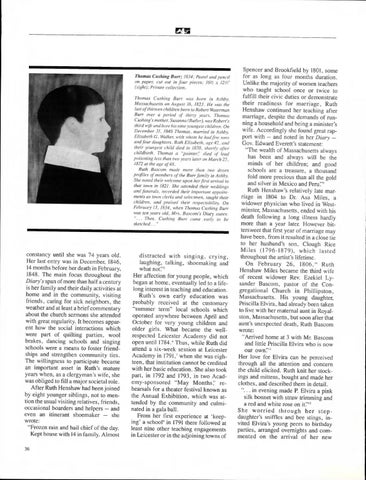Thomas Cushing Burr; 1834; Pastel and pencil on paper, cut out in four pieces; 161 / 2 x 121 / 2" (sight); Private collection. Thomas Cushing Burr was born in Ashby, Massachusetts on August 16, /823. He was the last ofthirteen children born to Robert Waterman Burr over a period of thirty years. Thomas Cushing's mother, Susanna(Butler), was Robert's third wife and bore his nine youngest children. On December 31, 1846 Thomas, married in Ashby. Elizabeth G. Walker, with whom he hadfive sons andfour daughters. Both Elizabeth. age 42, and their youngest child died in 1870. shortly after childbirth. Thomas a "painter:' died of lead poisoning less than two years later on March 25, 1872 at the age 0148. Ruth Bascom made more than two dozen profiles of members of the Burrfiimily in Ashby. She noted their welcome upon herfirst arrival to that town in 1821. She attended their weddings and funerals, recorded their important appointments as town clerks and selectmen, taught their children, and praised their respectability On February B. 1834. when Thomas Cushing Burr was ten years old, Mrs. Bascom's Diary states: ... Thos. Cushing Burr came early to be sketched..."
constancy until she was 74 years old. Her last entry was in December, 1846, 14 months before her death in February, 1848. The main focus throughout the Diary's span of more than half a century is her family and their daily activities at home and in the community, visiting friends, caring for sick neighbors, the weather and at least a brief commentary about the church sermons she attended with great regularity. It becomes apparent how the social interactions which were part of quilting parties, wool brakes, dancing schools and singing schools were a means to foster friendships and strengthen community ties. The willingness to participate became an important asset in Ruth's mature years when, as a clergyman's wife, she was obliged to fill a major societal role. After Ruth Henshaw had been joined by eight younger siblings, not to mention the usual visiting relatives, friends, occasional boarders and helpers — and even an itinerant shoemaker — she wrote: "Frozen rain and hail chief of the day. Kept house with 14 in family. Almost 36
distracted with singing, crying, laughing, talking, shoemaking and what not:' Her affection for young people, which began at home, eventually led to a lifelong interest in teaching and education. Ruth's own early education was probably received at the customary "summer term" local schools which operated anywhere between April and October for very young children and older girls. What became the wellrespected Leicester Academy did not open until 1784." Thus, while Ruth did attend a six-week session at Leicester Academy in 1791,7 when she was eighteen, that institution cannot be credited with her basic education. She also took part, in 1792 and 1793, in two Academy-sponsored "May Months:' rehearsals for a theater festival known as the Annual Exhibition, which was attended by the community and culminated in a gala ball. From her first experience at 'keeping' a school' in 1791 there followed at least nine other teaching engagements in Leicester or in the adjoining towns of
Spencer and Brookfield by 1801, some for as long as four months duration. Unlike the majority of women teachers who taught school once or twice to fulfill their civic duties or demonstrate their readiness for marriage, Ruth Henshaw continued her teaching after marriage, despite the demands of running a household and being a minister's wife. Accordingly she found great rapport with — and noted in her Diary — Gov. Edward Everett's statement: "The wealth of Massachusetts always has been and always will be the minds of her children; and good schools are a treasure, a thousand fold more precious than all the gold and silver in Mexico and Pere' Ruth Henshaw's relatively late marriage in 1804 to Dr. Asa Miles, a widower physician who lived in Westminster, Massachusetts, ended with his death following a long illness hardly more than a year later. However bittersweet that first year of marriage may have been, from it resulted in a close tie to her husband's son, Clough Rice Miles (1796-1879), which lasted throughout the artist's lifetime. On February 26, 1806," Ruth Henshaw Miles became the third wife of recent widower Rev. Ezekiel Lysander Bascom, pastor of the Congregational Church in Phillipston, Massachusetts. His young daughter, Priscilla Elvira, had already been taken to live with her maternal aunt in Royalston, Massachusetts, but soon after that aunt's unexpected death, Ruth Bascom wrote: "Arrived home at 3 with Mr. Bascom and little Priscilla Elvira who is now our own:" Her love for Elvira can be perceived through all the attention and concern the child elicited. Ruth knit her stockings and mittens, bought and made her clothes, and described them in detail. "... in evening made P. Elvira a pink silk bonnet with straw trimming and a red and white rose on She worried through her stepdaughter's sniffles and bee stings, invited Elvira's young peers to birthday parties, arranged overnights and commented on the arrival of her new
